Tennis / Racquet Sports Fitness
Generally played as a social able sport, most players will often use the game as a means to get fit, however if a strength and fitness program is worked on, the player would find rapid improvements in their game.
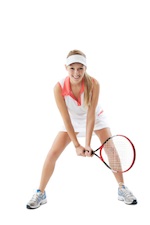 Tennis and squash players at the highest levels will need all-round areas of fitness - skill - strength and endurance to last the distance for matches that can be both physically and mentally very demanding.
Tennis and squash players at the highest levels will need all-round areas of fitness - skill - strength and endurance to last the distance for matches that can be both physically and mentally very demanding.
The training for each specific racquet sport will be slightly different, namely in the nature of each game:
Badminton will require a high skill level plus fast reaction.
Short bursts of explosive exercise, either sprinting, jumping or swinging the racket. Short recovery between each point, especially for squash and badminton when played at a high standard. With tennis having short rest breaks at various intervals of the game.
A lot of running around back and forth with plenty of lateral movement to both sides. Time on court can vary from 30 minutes to 3 hours plus, so a good endurance base is required for those that are serious about their sport.
There is no rest period during intense rallies, the rally stops when a player loses a point. Points are lost and won depending on the skills and fitness level of you the player. When you play your chosen racket sport, analysis each point you win and lose, with a number of different players to find your strength and weaknesses. Work on improving all areas, however start with the ones that you are weak on, in order to improve your game quickly.
Break your results down into two groups: -
Physical; Your fitness level, flexibility, and strength.
Mental; Co-ordination, skills, tactical abilities, and frame of mind.
Let's remember to get fit to play sport, not play sport to get fit, this way, we will enjoy the game more, and reduce the risk of injury. Improving your physical fitness side is straightforward; you need to improve your endurance by ideally a minimum of 30 minutes cardiovascular activity at the right level 3 times a week.
Avoid doing your cardiovascular workout before you play your game. Look in the Bodywork's section of the site under Heart and Lungs for suitable exercises, and Aerobic training in the Fitness section for guidelines on how hard to train.
Both weight training exercises and explosive leg exercises such as short sprints and plyometrics can improve explosive power. Remember to work within your own limits.
Aim to spend 1 day a week doing either sprint / plyometric work. As these are both very demanding, avoid if you have a low fitness level, or any injury.
For your sprint work, try and do the sprints on the court you play on, wearing the same training shoes you play in. There are many variations, however keep them short as for your sport.
Shuttle sprints, from baseline to serving box and back, then up to the net and back. You can repeat this with either no rest or short rest. For best results run against a partner.
As above but sprint forward, and run backwards coming back.
Ball retrieval, place a number of balls across the court, sprint to each one pick it up, return it to the baseline, continue until all balls are recovered. Try timing yourself.
Partner Ball Throw, Stand with your back towards the net or wall, with your eyes shut, have your partner throw a ball in the air behind you somewhere. When they say "go", aim to reach the ball as quickly as possible, you can also aim to hit the ball over the net etc. with your racket.
North South East West, Sprint North towards the net / wall, as you get half way, side step East to the sideline / wall, then continue to sprint North. On reaching the net / wall, run backwards to halfway mark, and side step West to side line, then run back again to baseline. Take care when running backwards.
STRENGTH TRAINING The following exercises will help increase your body strength, resulting in greater power. Aim to do these strength / aerobic training sessions if possible twice a week, especially in the off season. The members area will give you a full exercise description, plus a number of different workouts to gain all over body strength using both machine and free weights - speed and flexibility to improve your game.
The key area for improving the power behind your serving and returning of the ball, will come from a strong core stability muscle mid-section. Our members area has over 200 different exercises for the abdominal's, including a number of different workouts which are suitable for all fitness levels, using body weight - Swiss Balls and medicine balls - why not take a look and see how you and your game can benefit.
Use the lower body workout within the gym workouts section to help strengthen the muscles of your lower body, spending time trying additional exercises such as lunges in all directions (forward - back and both sides).
Use the upper body workout within the gym workouts section to help strengthen the muscles of your upper body.
Along with these exercises, you should aim to do the following at least twice a week, to aid prevention from tennis elbow, and shoulder instability, which can occur due to the muscles in your chest and front (deltoid) shoulder becoming stronger than those of your back.
|
|
||
 |
 |
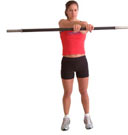 |
|
Large rotations of a disk weight / heavy plate for 30 seconds in each direction. Keep the movement from the wrist.
|
Grasp a disk weight / heavy book between your fingers - holding for 30 seconds plus - keep weight close to the floor.
|
Hold a suitable bar or broomstick at arms length - smoothly cross over your hands towards the ends of the bar - keeping the bar horizontal. Aim for 5 moves in each way.
|
|
|
|||
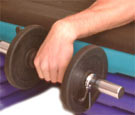 |
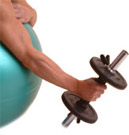 |
 |
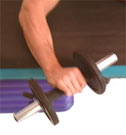 |
|
|
|||
|
|
||||
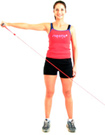 |
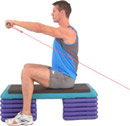 |
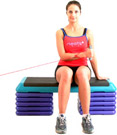 |
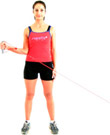 |
|
As with most sports, people forget to stretch prior to the start of the game. With all racquet sports having sudden bursts at any point in the game, it is vital to stretch the whole body in order to prevent injury. After a gradual warm-up spend time stretching, both statically; (see the section on stretching in the fitness area of the Web Site), then DYNAMICALLY.
Dynamic stretching involves slow controlled rhythmic movements progressively through the range of movements associated with your game. A section on dynamic stretching will be added to the site.
At the end of your game, again spend a few minutes stretching your muscles. The members area has a complete section specifically designed for stretching for racket sports, along with a full explanation of over 1,000 different exercises and stretches.
Co - ordination / Skills
Eye - Body - Brain, is the way we want to have our co-ordination and skills. Unfortunately many of us see the ball, and our body takes too long to react to it passing us. This area can be improved by developing what is called your motor skills, so that you see the ball, and your body automatically positions itself in the correct place.
With a complete variety of situations you can be in, for a ball to pass you, you need to work on improving your total body, to react as one fast efficient machine.
FOOT DRILLS Used to gain speed in footwork, lay out a rope ladder, or chalk out an area with approximately 15 inch squares. Combining ladders so that you go both forward and sideways, will give you rapid results. The numbers indicate the order to run in.
|
1 |
2
|
3 |
4
|
5 |
6
|
Single leg run; aim to run on the ball of your foot, without catching the rope or chalk lines. |
|
|
|
|
|
|
|
Double leg run; aim to run at speed through the rope ladder, pumping with your arms. |
|
1 2 |
3 4 |
5 6 |
7 8 |
9 10 |
11 12 |
Double side step, run through the ladder in a sideways direction. |
|
|
|
|
||||
|
|
|
|
|
|
|
Ickey Shuffle, As with the double run, but this time every third step comes outside the rope. |
|
|
|
|
|
|||
|
1 |
2 |
3 |
4 |
5 |
6 |
Cross overs, Side step through the rope, taking your leading leg both in front and then behind the trailing leg. |
By performing these drills in both directions, you will soon realize that you are better on one side than the other. Aim to work on your weaker side for greater improvements in your game.
The following drills with help improve hand / eye speed
Ball Drops: Have a partner hold a ball in each hand, and get them to drop one of them without warning in front of you. Your aim is to catch the ball before it hits the floor.
Balloon & Foot: Blow two balloons up, and spend time keeping them up in the air by either hitting them with a racket, or kicking them with your feet.
Hand Changes: Playing against a wall with a ball, constantly hit the wall changing hands rapidly between shots, aim to get as close to the wall as possible.
Ball over Shoulder: Looking straight ahead, have a partner drop a ball over your shoulder, aim to hit the ball as quickly as possible either over the net or against the wall.
Balance Ball Bounce: If possible work on a wobble board, whilst a partner bounces balls towards you. The aim is to rapidly change your position whilst being off balance.
Ball Play: Working on your bad shots, have a partner constantly play against these shots so that you can analysis what you are doing wrong.
Remember becoming fitter will certainly help your chosen racquet sport, however good advice from a qualified coach, or simply watching professionals play, will help improve both your tactical ability and skills for the game.
A positive frame of mind is essential in all sports, if you want to be a winner. Avoid getting negative, or simply giving up the game, especially in Tennis. Work hard for every point, aim to win every point, and watch the pressure you put on your opponent, when you are 40 / 0 down but trying your hardest just to make it 40 / 15. It is here that your opponent will start to get double faults, or simply get frustrated with their game.
Remember that not everyone wants to win, some people will play the game for the enjoyment, I hope that these notes will improve your game, and enable you to play with players that are normally of a higher level.
Stretching
- Racketball requires a combination of speed, power, skill and reaction.
- Squash, the rallies generally last longer, with both skill and a knowledge of the game being useful.
- Tennis, a game can be won by just a few points being gained, and as such a strong positive mind will be needed as well as a strong body, as the sport is becoming more and more physically demanding.